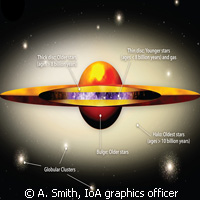Andromeda's telltale finery
An international team of astronomers has set its sights on the Andromeda galaxy, a close neighbour, and observed a volley of stars which map out a thick stellar disc. As these stars are older than those forming Andromeda's thin disc, this discovery is expected to widen the scope for research into the formation and evolution of galaxies such as our own. The team's findings will be published in the upcoming Monthly Notices of the Royal Astronomical Society. Like the Milky Way, our galactic home, Andromeda is a large spiral galaxy - one with a stellar disc of spiral arms surrounding a bulge of stars at the core. 'From observations of our own Milky Way and other nearby spirals, we know that these galaxies typically possess two stellar discs, both a "thin" and a "thick" disc,' explains the leader of the study, Ms Michelle Collins, a PhD student at the University of Cambridge's Institute of Astronomy in the UK. The thin disc contains regions of active star formation, whereas the thick disc where it is embedded is formed by older stars. Together with colleagues in Australia, France, the UK and the US, Ms Collins analysed measurements of the velocities of individual bright stars within the Andromeda galaxy using the Keck telescope in the US state of Hawaii. The results of this joint effort have enabled the team to propose a first characterisation of the newly identified disc. 'Our initial study of this component already suggests that it is likely older than the thin disc, with a different chemical composition,' comments Dr Mike Rich of the UCLA (University of California, Los Angeles), a co-author of the study. 'Future more detailed observations should enable us to unravel the formation of the disc system in Andromeda,' he adds, 'with the potential to apply this understanding to the formation of spiral galaxies throughout the universe.' Ms Collins explains. 'The classical thin stellar discs that we typically see in Hubble imaging result from the accretion of gas towards the end of a galaxy's formation,' she says, 'whereas thick discs are produced in a much earlier phase of the galaxy's life, making them ideal tracers of the processes involved in galactic evolution.' Most of our own galaxy's thick disc is hidden from our view, whereas Andromeda's entire thick disc can be observed from the Milky Way. This provides astronomers with a golden opportunity to analyse the properties of the disc and search for clues to the events that shaped it. 'This result is one of the most exciting to emerge from the larger parent survey of the motions and chemistry of stars in the outskirts of Andromeda,' says Dr Scott Chapman, a fellow team member from the Institute of Astronomy. 'Finding this thick disc has afforded us a unique and spectacular view of the formation of the Andromeda system and will undoubtedly assist in our understanding of this complex process.' Sometimes, it pays to keep tabs on the neighbours.For more information, please visit: Institute of Astronomy:http://www.ast.cam.ac.uk/~mlmc2/M31thickdisc.htmlRAS:http://www.ras.org.uk
Countries
Australia, France, United Kingdom



